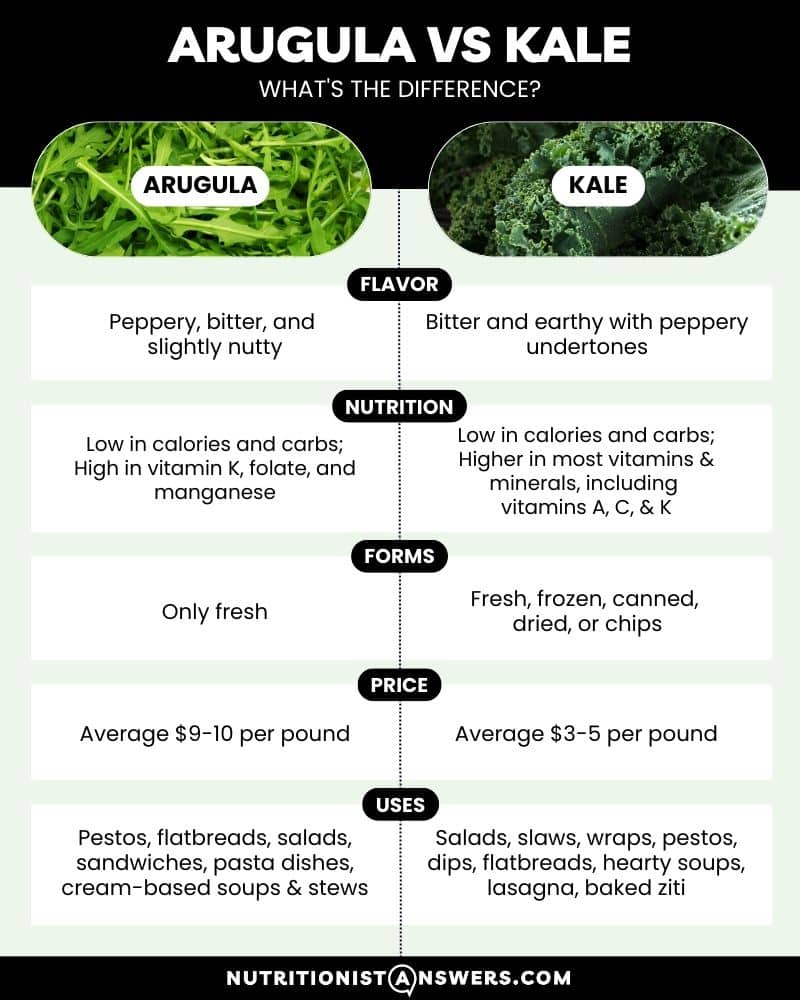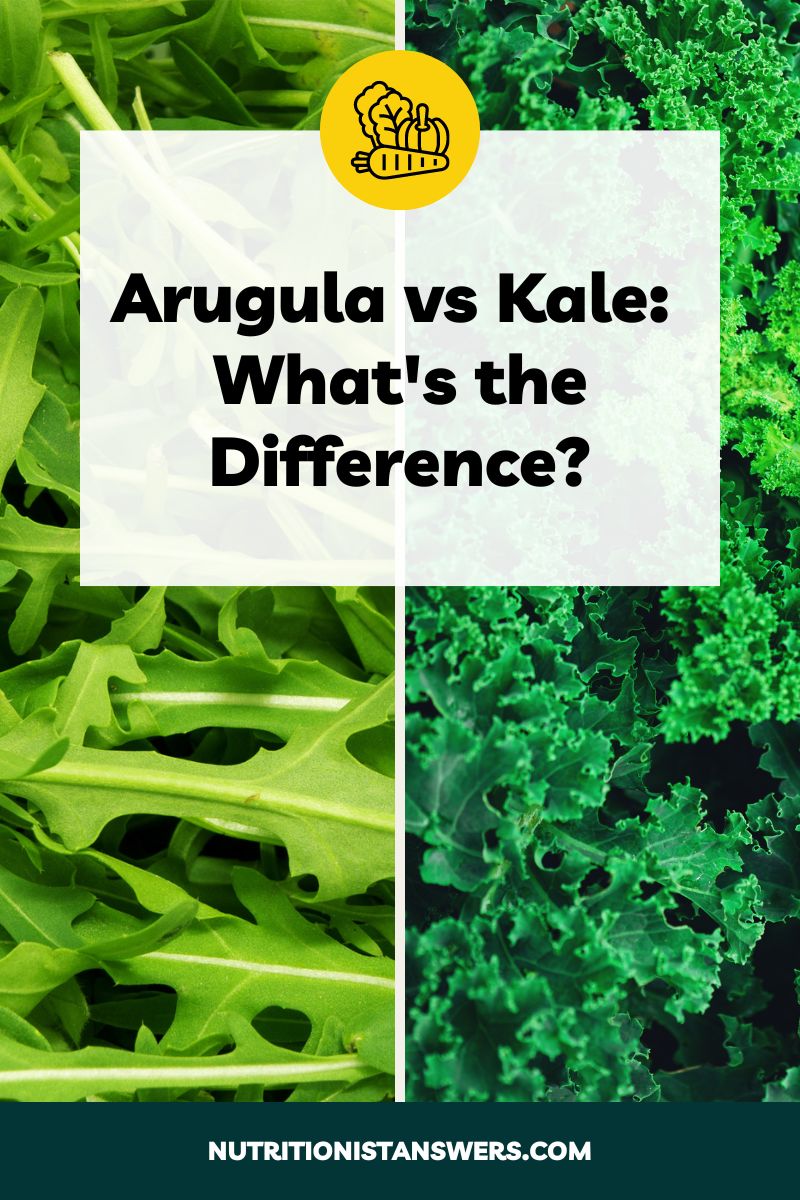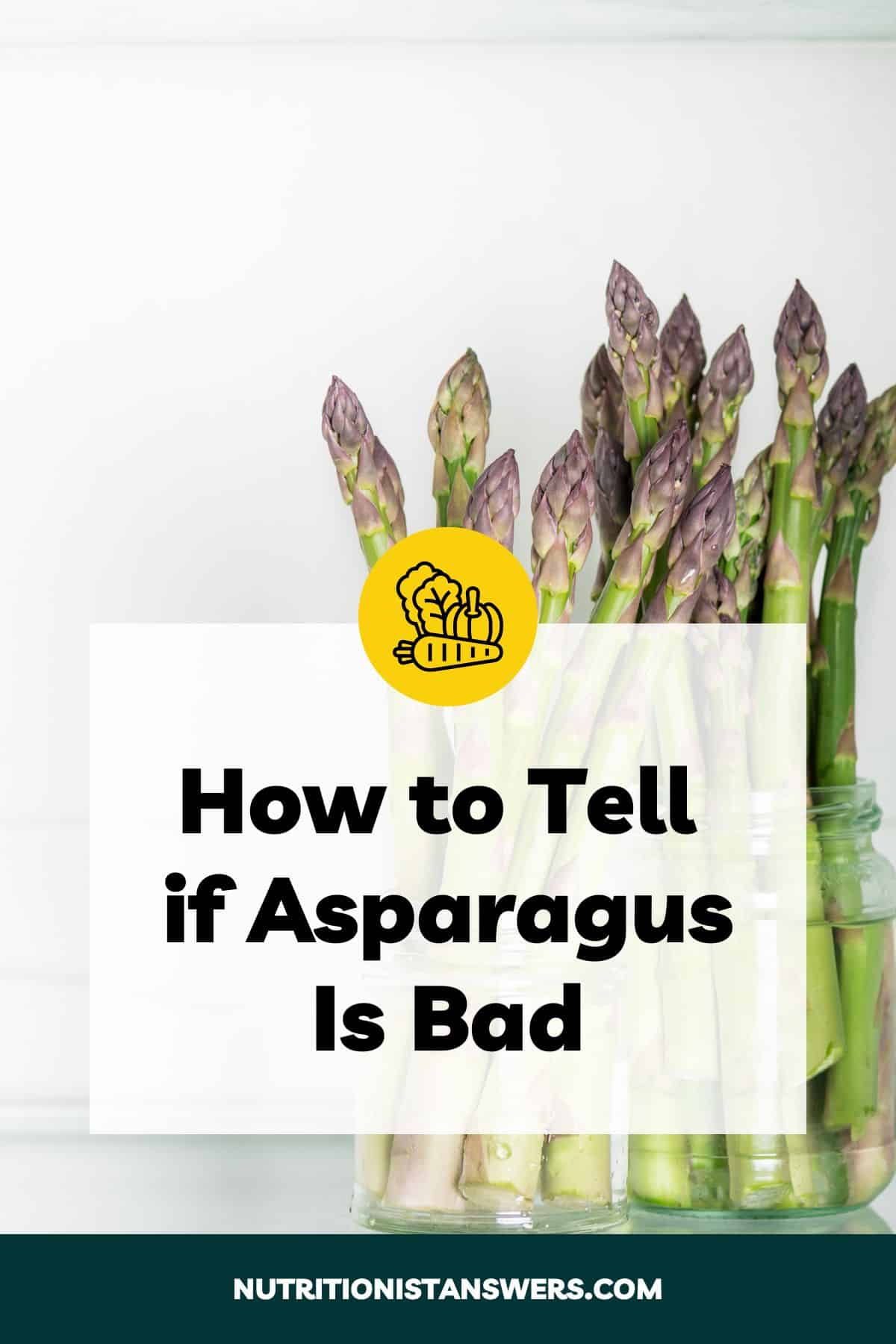Arugula and kale are two of the most popular leafy greens, each boasting a unique flavor profile and an impressive array of health benefits.
While they share many similarities, these two greens also have some important differences in flavor, texture, and how they’re prepared.
In this article, we’ll explore the similarities and differences between arugula and kale, in terms of nutrition, taste, available forms, prices, and uses.

Please note that this article contains affiliate links. If you click one of these links and make a purchase, we may earn a commission. As an Amazon Associate, we earn from qualifying purchases.
What is arugula?
Arugula, also called rocket, is a leafy green vegetable belonging to the Brassica (cruciferous) family along with kale, broccoli, and cabbage (1). While native to the Mediterranean region, arugula is now grown worldwide.
Arugula leaves are bright green and have lobes that can be either rounded or pointed at the end. They look similar to dandelion leaves but with fewer jagged edges.
With a pungent, peppery flavor and a hint of bitterness, arugula is known for its unique taste. Its leaves are sturdy but offer a slight crunch that adds texture to salads and side dishes.
You can typically find fresh arugula in the produce section of most grocery stores, often packaged in plastic clamshell containers or bags. It’s also often sold at farmers markets and health food stores.
Most often tossed into salads for its peppery punch, arugula also shines when mixed in pasta dishes, sprinkled on pizza, slipped into sandwiches, or blended into pesto for a unique flavor twist.
What is kale?
Kale is a leafy green (and sometimes purple) vegetable that originated in Central Asia. It also belongs to the Brassica (cruciferous) family, which also includes cauliflower, Brussels sprouts, and arugula (2).
Kale leaves are large, curly, and dark green with a hardy, fibrous stem running through the middle, but they can vary depending on the variety. For instance, Lacinato kale (also known as dinosaur kale) features dark green bumpy leaves that resemble dinosaur skin.
Boasting a robust, slightly bitter taste with earthy and peppery undertones, the flavor of kale can mellow and sweeten when cooked. Its texture is quite dense when raw but turns tender when sauteed or crisp when baked.
Kale is usually found in the produce section of grocery stores, either loose in bundles or pre-packaged in plastic bags. It’s also often available pre-washed and chopped for convenience.
Kale is commonly used in soups and salads but can also be sautéed as a side dish, blended into green smoothies, or baked into crispy kale chips.
Arugula vs kale
Arugula has a pungent, peppery flavor and a delicate, spinach-like texture, while kale is known for its strong, earthy taste and tough, crunchy leaves and stems.
Both arugula and kale are low in calories, fat, and carbohydrates and provide a small amount of protein. Kale contains twice the amount of fiber (2 grams per serving) as arugula.
Kale is higher in most vitamins and minerals than arugula. However, both greens are high in folate, manganese, calcium, and vitamins A, C, and K.
Here’s a more detailed review of how arugula and kale compare in flavor, nutrition, available forms, prices, and recommended uses:
Flavor comparison
Arugula has a pungent flavor that is peppery, bitter, and a bit nutty. Its texture is similar to raw spinach but with wispy leaves and thin stalks, offering a slight crispness when fresh.
Kale is known for its strong, earthy taste and dry, tough, and crunchy texture when eaten raw. Once cooked, kale becomes milder and sweeter, and its texture softens.
Arugula’s peppery flavor pairs well with sweet fruits, balsamic vinegar, and mild cheeses, whereas kale’s robust, earthy taste is complemented by strong flavors like garlic, olive oil, and hearty proteins.
Nutrition comparison
Here’s a side-by-side comparison of the calorie and macronutrient content of raw arugula and kale, based on a 2-cup (50-gram) serving size (3, 4):
| Nutrient | Arugula, raw (50 grams) | Kale, raw (50 grams) |
| Calories | 13 | 18 |
| Protein | 1.3 grams | 1.5 grams |
| Fat | 0.3 grams | 0.7 grams |
| Carbohydrates | 1.9 grams | 2.2 grams |
| Fiber | 0.8 gram | 2.1 grams |
Calories
Both arugula and kale are low-calorie foods, each providing less than 20 calories per 2-cup (50-gram) serving of raw greens.
However, kale is slightly higher in calories with 18 calories per 2-cup serving, while arugula has 13 calories in the same serving size.
Protein
Like most other vegetables, kale and arugula provide a very small amount of protein, each offering less than 2 grams per 2-cup (raw) serving.
Fat
Kale and arugula are both very low in fat — a 2-cup (raw) serving of each provides less than 1 gram of fat.
Carbohydrates
Both arugula and kale are low in carbohydrates.
Kale offers 2.2 grams of carbohydrates per serving, and almost all (2.1 grams) of these carbohydrates come from fiber.
Arugula, on the other hand, provides 1.9 grams of carbohydrates and 0.8 grams of fiber per 2-cup serving.
Vitamins and minerals
Here’s an overview of the vitamin and mineral content of raw arugula and kale, based on a 2-cup (50-gram) serving (3, 4):
| Nutrient | Arugula, raw (50 grams) | Kale, raw (50 grams) |
| Vitamin A | 60 mcg RAE (6% DV) | 121 mcg RAE (163% DV) |
| Vitamin B1 (Thiamin) | 0.02 mg (2% DV) | 0.06 mg (5% DV) |
| Vitamin B2 (Riboflavin) | 0.04 mg (3% DV) | 0.17 mg (13% DV) |
| Vitamin B3 (Niacin) | 0.2 mg (1% DV) | 0.6 mg (4% DV) |
| Vitamin B5 (Pantothenic acid) | 0.2 mg (4% DV) | 0.2 mg (4% DV) |
| Vitamin B6 (Pyridoxine) | 0.04 mg (2% DV) | 0.07 mg (4% DV) |
| Vitamin B9 (Folate) | 49 mcg (12% DV) | 31 mcg (8% DV) |
| Vitamin B12 (Cobalamin) | 0 mcg (0% DV) | 0 mcg (0% DV) |
| Vitamin C | 8 mg (9% DV) | 47 mg (52% DV) |
| Vitamin D | 0 mcg (0% DV) | 0 mcg (0% DV) |
| Vitamin E | 0.2 mg (1% DV) | 0.3 mg (2% DV) |
| Vitamin K | 55 mcg (46% DV) | 195 mcg (163% DV) |
| Choline | 8 mg (1% DV) | <1 mg (<1% DV) |
| Sodium | 14 mg (1% DV) | 27 mg (1% DV) |
| Potassium | 185 mg (4% DV) | 174 mg (4% DV) |
| Calcium | 80 mg (6% DV) | 127 mg (10% DV) |
| Phosphorus | 26 mg (2% DV) | 28 mg (2% DV) |
| Magnesium | 24 mg (6% DV) | 17 mg (4% DV) |
| Iron | 0.7 mg (4% DV) | 0.8 mg (4% DV) |
| Zinc | 0.2 mg (2% DV) | 0.2 mg (2% DV) |
| Copper | 0.04 mg (4% DV) | 0.03 mg (3% DV) |
| Manganese | 0.2 mg (9% DV) | 0.5 mg (22% DV) |
| Selenium | 0.2 mcg (<1% DV) | 0.5 mcg (1% DV) |
Both kale and arugula provide a good amount of folate, manganese, calcium, and vitamins A, C, and K. However, kale is higher in most vitamins and minerals than arugula.
Kale is especially high in vitamins A and K, providing 163% of the DV per 2-cup (raw) serving for each. It also offers more than 50% of the DV for vitamin C.
Arugula offers slightly more folate, magnesium, and copper than kale, but there’s only a 1-4% difference in the DV for each of these nutrients.
Special Diets
If you’re following a special diet, you may be wondering whether arugula or kale are a better choice for you.
Dairy free diet
Both arugula and kale are naturally dairy-free.
Gluten free diet
Kale and arugula are naturally gluten-free and can be consumed on a gluten-free diet.
Ketogenic diet
Arugula and kale contain about 2 grams of carbohydrates per 2-cup (raw) serving, making them excellent choices for people following a keto diet.
Low fat diet
Kale and arugula are both very low in fat, with less than 1 gram per 2-cup (raw) serving, making them ideal options for people who need to limit their fat intake.
Keep in mind that cooking oil and salad dressings will increase the fat content of dishes made with these greens, so use them in moderation if you’re following a low-fat diet.
Low-FODMAP diet
Both arugula and kale can be consumed freely on a low-FODMAP diet. According to the Monash app, only trace amounts of FODMAPs have been detected in these greens.
Low sodium diet
Kale and arugula are both naturally low in sodium. However, canned kale includes added salt and may contain more than 300 mg of sodium per serving (5).
If you’re following a low-sodium diet, which limits sodium to less than 2300 mg, you may want to choose canned goods with no added salt if you can find them (6).
Another option is to rinse canned foods before eating them — this helps to reduce the amount of sodium they contain (7).
Vegetarian diet
Both arugula and kale are plant-based and can be eaten on a vegetarian diet.
Vegan diet
Kale and arugula are both vegan, since they are plants.
Available forms
1. Fresh (arugula and kale)
Fresh arugula and kale are widely available in supermarkets and health food stores, where they are typically found in the produce aisle packaged in plastic bags, clamshells, or tied in bunches..
You might also be able to find kale and arugula at farmers markets, especially when they are in season in the spring or fall.
2. Frozen (kale only)
Many grocery stores carry frozen chopped kale, often packaged in steamable plastic bags. Frozen kale can be added to green smoothies, tossed into soups, or used in egg-based dishes like quiche.
We weren’t able to find any frozen arugula products. Technically, arugula can be frozen, but its delicate and tender leaves are easily damaged by the cold temperatures and often turn to mush after defrosting.
3. Canned (kale only)
Canned kale isn’t common but can occasionally be found at supermarkets in the canned goods aisle or online. Glory Foods is a brand of canned seasoned kale available on Amazon.
We aren’t aware of any brands that offer canned arugula. Because arugula is so delicate and can become mushy very quickly, canning isn’t recommended.
4. Dried (kale only)
Most supermarkets don’t carry dried kale, but you might be able to find some at health food markets or online. Thousand Lakes is a brand that offers freeze dried diced kale on Amazon.
Dried kale is a convenient, shelf-stable option that can be blended into sauces and marinades, mixed into dips, and sprinkled over savory baked goods.
Arugula usually isn’t available dried, but you can dry your own arugula at home using an oven or food dehydrator.
5. Chips (kale only)
Kale chips are a nutritious snack made by tossing pieces of kale in olive oil and salt, then baking until they’re crisp, offering a more nutrient-dense alternative to traditional potato chips.
Many grocery stores and health food markets offer kale chips in the snack aisle, and they can also be purchased online.
While arugula chips aren’t available in stores, you can try making your own at home. Their delicate leaves aren’t as well-suited to baking as kale, but arugula chips can still be crisp and delicious.
Cost
Arugula is usually 2-3 times more expensive than kale.
A 1-pound (16-ounce) bag of fresh kale typically costs $3-5, while the same amount of fresh arugula would cost around $9-10.
You can save money by growing your own greens at home. Arugula and kale prefer cool weather, so they should be planted in the early spring for spring harvest or late summer for fall harvest.
Recommended uses
Arugula and kale can be used in many of the same ways.
1. Salads and side dishes
Arugula and kale are versatile greens that can be used as a base for salads or tossed into side dishes with whole grains and lentils or beans.
Arugula is perfect for adding a peppery kick to salads and pairs well with robust flavors like citrus fruits, goat cheese, and tangy vinaigrettes.
Kale pairs nicely with fruits like apples and dried cranberries, cruciferous veggies like cabbage and Brussels sprouts, and hearty proteins like grilled chicken. Don’t forget to massage the kale with a drizzle of oil to soften its texture before adding it to your salad.
If your dish requires cooked greens, kale may be a better choice, as arugula’s delicate leaves often turn to mush when heated.
2. Sandwiches and wraps
Incorporating arugula or kale into your sandwiches and wraps can add a nutritional punch and a flavorful twist.
Arugula, with its peppery flavor, is a great addition to Italian-inspired sandwiches, pairing well with ingredients like prosciutto, mozzarella, and sun-dried tomatoes.
On the other hand, kale’s robust texture makes it an excellent choice for wraps, especially when combined with hearty fillings such as grilled chicken, roasted vegetables, or hummus.
A quick sauté or steam can soften kale’s texture if desired, while arugula can be used fresh for a lively bite.
3. Pestos and dips
Arugula and kale can both be incorporated into a variety of pestos and dips for a boost of flavor and nutrition.
Arugula is an excellent choice for making vibrant pestos with garlic, pine nuts, parmesan, and olive oil. Try stirring some arugula pesto into pasta dishes or using it as a base for pizza toppings.
Kale’s flavor lends itself to milder, earthier pestos and pairs well with tahini, lemon juice, and soft cheeses in dips. It can be used to replace spinach in the classic appetizer, kale artichoke dip.
4. Pizzas and flatbreads
Kale and arugula can bring a fresh, nutritious twist to your pizzas and flatbreads.
Arugula is often added raw to pizzas after they come out of the oven, pairing particularly well with classic toppings like tomatoes, mozzarella, and prosciutto.
Kale can be lightly sautéed with garlic and olive oil before being added to a pizza or flatbread, complementing ingredients like sausage, sweet potato, or gorgonzola cheese.
5. Soups and stews
Incorporating leafy greens like arugula and kale into your soups and stews can elevate their taste and nutritional content.
Arugula’s peppery flavor works well in lighter, broth-based soups and pairs nicely with ingredients like potatoes, white beans, and lemon juice. It’s best added toward the end of cooking to preserve its flavor and texture.
Kale, with its sturdy texture, is an excellent addition to heartier stews and chilis, where it can simmer for a while without losing its structure. It tastes great with sausage, beans, and carrots.
6. Pasta dishes
For a fresh twist on pasta dishes, consider including arugula or kale.
Arugula pairs well with garlic butter sauce, parmesan cheese, and lemon zest. Simply toss it with freshly cooked pasta, while it is still hot — this allows the leaves to wilt without becoming mushy.
If you prefer heartier dishes like lasagna or baked ziti, kale is a great choice. You can sauté kale with garlic and mix it into the sauce for added texture and nutrients.
Final thoughts
Arugula is known for its pungent, peppery flavor and delicate leaves, while kale tastes strong and earthy, with tough, crunchy leaves.
Kale and arugula are low in calories and carbohydrates and offer a small amount of fiber. Kale is higher in most vitamins and minerals, but both greens offer a good amount of folate and vitamin K.
Arugula is usually only available fresh, but kale can be found in other forms, including frozen, canned, and even dried. Kale is often 2-3 times cheaper than arugula.
Both greens can be used in many of the same ways in salads, sandwiches, pizzas, soups, pasta dishes, and dips.
Interested in how arugula differs from other leafy greens? Check out our in-depth article comparing Arugula vs Spinach as well.
Amy Richter is a Registered Dietitian Nutritionist based in Missouri. She is an experienced nutrition writer and medical advisor for Healthline and Medical News Today. Amy is passionate about all things food-related and enjoys translating complex science into easy-to-understand articles.





